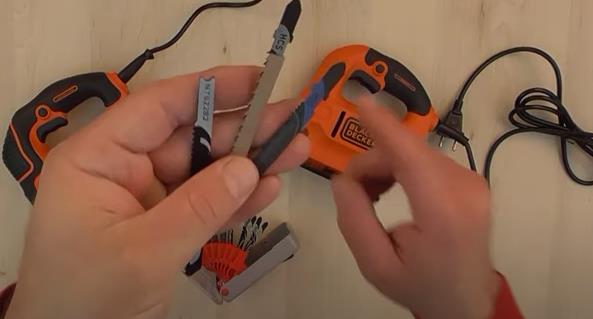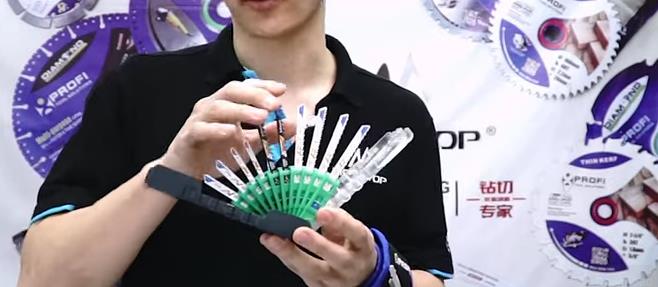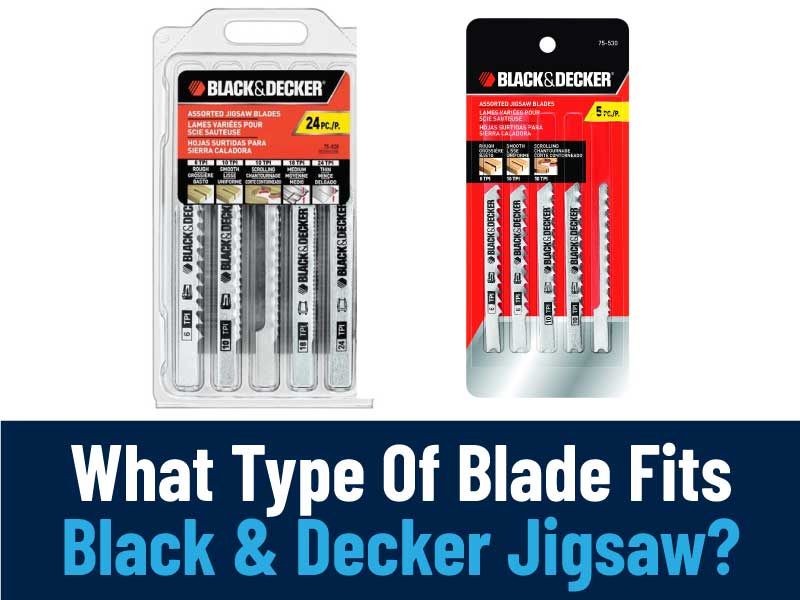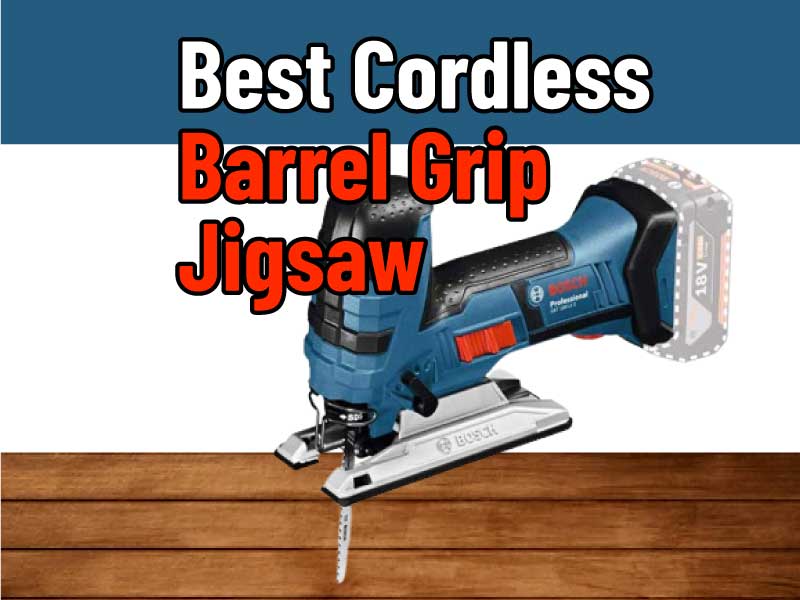Any 1/4″ universal shank jigsaw blade.
When finding the right blade for your Black & Decker jigsaw, the best place to start is by looking at the model number of your saw. This blog on what type of blade fits Black & Decker jigsaws will help you identify the right blade size and type for your specific jigsaw.
Black & Decker jigsaws use either T-shank or U-shank blades. T-shank blades are the most common type of blade used for these saws and will fit most models. Once you know the model number of your saw, you can then start narrowing down the type of blade you need.
If you are unsure of the model number of your saw, another way to identify the right blade is by the type of material you will be cutting. Jigsaws from Black & Decker can cut through wood, plastic, and metal, among other things.
However, Black & Decker offers a variety of blades for their jigsaws, so you should have no problem finding the right one for your needs. Also, my blog helps you find out the blade types, models, etc. So read on.
What Type Of Blade Fits Black & Decker Jigsaw?

A jigsaw is a power tool that uses reciprocating motion to make straight or curved cuts in materials. The blade is the most critical part of the jigsaw, as it determines the type of cuts you can make and the quality of the finished product.
The Black & Decker jigsaw accepts various blade types, including T-shank, U-shank, and bayonet-style blades. Each blade type has its unique features and benefits.
T-Shank Blades
T-shank blades are the most common type of jigsaw blade and are the standard for most Black & Decker jigsaws. The shank of these blades is in the shape of a T, which makes them fit securely in the blade clamp of a jigsaw. T-shank blades come in different sizes and tooth patterns, so they can be used for a wide range of cutting tasks.
Some of the most popular T-shank blades for the Black & Decker jigsaw include:
- Wood blades for cutting softwoods, hardwoods, and engineered wood products
- Metal blades for cutting sheet metal, pipes, and other metal materials
- Composite blades for cutting a variety of materials, including wood, metal, and plastic
U-Shank Blades
U-shank blades are older jigsaw blade that is less common today. The shank of these blades is in the shape of a U, which makes them fit securely in the blade clamp of a jigsaw. U-shank blades are usually cheaper than T-shank blades and can be used for a wide range of cutting tasks.
You can still find these blades available if you have an older Black & Decker jigsaw that uses U-shank blades. However, if you’re in the market for a new jigsaw, it is recommended that you choose a model that uses T-shank blades, as these blades are more widely available and offers better performance.
Bayonet-Style Blades
Bayonet-style blades are a newer type of jigsaw blade that has become increasingly popular in recent years. The unique bayonet-style shank of these blades makes them fit securely and steadily in the blade clamp of a jigsaw. Bayonet-style blades come in different sizes and tooth arrangements, so they can be used for a wide range of cutting tasks.
Some of the benefits of using bayonet-style blades with your Black & Decker jigsaw include:
- Quick and easy blade changes
- Improved accuracy and precision
- Longer blade life
Yet, for cutting wood, you will want to use a blade with a minimum of 10 teeth per inch (TPI). You will want a blade with at least 14 TPI for cutting plastic. And for cutting metal, you will want a blade with 18 or more TPI.
Once you know the model number of your saw and the type of material you will be cutting, you can then narrow down the specific blade you need.
Related: Best cordless jigsaws for woodworking
How To Find The Model Number Of Your Black & Decker Jigsaw?
The model number of our Black & Decker jigsaw is JS510.

If you need to find the model number of your Black & Decker jigsaw, there are a few simple steps you can follow.
First, locate the nameplate on the tool. The model number will be listed on this nameplate. If the nameplate is not visible, you can also find the model number stamped into the tool’s body.
Once you have located the model number, you can use it to look up manuals, parts, and other information about your jigsaw.
For example, say you need to find the model number of your Black & Decker jigsaw because you need to order a new blade. You would start by locating the nameplate on the tool.
The model number will be listed here. In this case, let’s say the model number is “BDJ-1000”. You can then use this model number to look up the correct blade for your jigsaw. You can also use the model number to find a manual or other information about your jigsaw.
What Is The Kerf Of The Blade You Need?
There is no one answer to this question because the kerf, or width of the blade, needed depends on the specific project being completed.
If you’re a woodworker, metalworker, or fabricator, you’ve probably heard ” kerf “. But what is the kerf of a blade?
In short, the kerf is the width of the blade’s cut. This is important because it will affect the amount of material you need to remove and the size of the final cut.
For example, let’s say you’re cutting a piece of wood that is 1″ thick. If you’re using a blade with a kerf of 0.5″, then you’ll need to remove 1/2″ of material to make your final cut.
Now, let’s say you’re using a blade with a kerf of 0.75″. In this case, you’ll need to remove 3/4″ of material to make your final cut.
As you can see, the blade’s kerf can significantly impact the material you need to remove. That’s why it’s essential to know the blade’s kerf before starting your project.
If you’re not sure what the kerf of your blade is, you can usually find this information on the packaging. If you can’t find it there, you can always contact the manufacturer to ask.
Now that you know what the kerf is, let’s see an example of how this can affect your project.
Let’s say you’re building a table and need to cut four legs out of 2″x4″ lumber. If you’re using a blade with a kerf of 0.5″, you’ll need to remove 2″ of material from each 2″x4″ board. This means you’ll need to start with eight 2″x4″ boards that are 8′ long.
However, if you’re using a blade with a kerf of 0.75″, you’ll need to remove 3″ of material from each 2″x4″ board. This means you’ll need to start with six 2″x4″ boards that are 8′ long.
As you can see, the blade’s kerf can greatly impact the amount of lumber you need to purchase for your project. So, before you start your next project, check the blade’s kerf to ensure you have enough material.
What Is The Plate Thickness Of The Blade You Need?
The thickness of the plate should be 1/4 inch.
This is a common question asked by many people looking to purchase a new blade for their saw. The answer to this question is not as simple as it may seem. The plate thickness of the blade you need depends on a few different factors.
- Consider the saw you are using. The first factor to consider is the saw you are using. The thickness of the blade plate is different for a circular saw, and a jigsaw saw.
- Consider the material you will be cutting. The blade plate thickness for a wood blade differs from that of a metal blade.
- The last factor to consider is the depth of the cut you need to make. The deeper the cut, the thicker the blade plate needs to be.
Now that you know the three main factors to consider when determining the plate thickness of the blade you need, let’s look at an example.
Let’s say you are using a circular saw to cut through a piece of plywood that is 1 inch thick. For this application, you would need a blade with a plate thickness of at least 1/8 inch. If you were using a table saw to cut the same piece of plywood, you would need a blade with a plate thickness of at least 1/4 inch.
As you can see, the answer to the question “What is the plate thickness of the blade you need?” is not always a simple one. There are a few factors you need to consider before you can determine the correct answer.
What Is The Bore Of The Blade You Need?
The bore of the blade you need is 3 inches.

When you’re shopping for a new saw blade, one of the things you need to know is the bore of the blade. The bore is the hole in the blade’s center that fits over the saw’s arbor. The size of the arbor determines the size of the bore on your saw.
For example, let’s say you have a circular saw with a 5/8-inch arbor. The bore of the blade you need would be 5/8 inches. Most standard circular saw blades have a 5/8-inch bore, so you should have no problem finding one that fits your saw.
But what if you have a unique saw with a different size arbor? In that case, you’ll need to find a blade with a custom bore size. You can usually find these blades at specialty saw shops or online.
Now that you know what the bore of a saw blade is and how to find the right size for your saw, you’re ready to start shopping for a new blade. Remember that the bore is just one of the many factors you need to consider when choosing a blade.
Things like tooth count, kerf, and material can all affect how well a blade performs. But if you take your time and do your research, you should be able to find the perfect blade for your next project.
How to Choose the Right Blade for Your Black & Decker Jigsaw?

Picking the right blade for your Black & Decker jigsaw is crucial if you want to make accurate and quick cuts. Here are some essential things to think about when choosing a blade:
Material:
Think about what you are going to be cutting. Different kinds of materials need different kinds of blades, like wood blades, metal blades, or blades that are made especially for cutting plastic or ceramics.
Tooth Configuration:
How the blade’s teeth are set up, or how far apart they are, can affect how fast and smooth the cut is. Fine-toothed blades are best for precise cuts, while coarse-toothed blades are better for making rough cuts or cutting through thicker materials.
Blade Length:
The length of the blade affects how deep you can cut and how stable the blade is while you use it. Choose a blade length that fits the thickness of the material you want to cut.
Blade Thickness:
The thickness of the blade can affect how strong it is and how well it can cut through different materials. Most of the time, thicker blades are stronger but can also be more rigid. This makes them less flexible and less good for cutting curves or small details.
Quality:
When choosing a blade, pick one that is made for the cutting you want and is of high quality. Blades that aren’t made well can bend or break easily, leading to accidents or damage to your jigsaw.
By thinking about these things, you can pick the right blade for your Black & Decker jigsaw and get the best cutting results for your needs.
Tips for Maintaining Your Blades for Black & Decker Jigsaws and Maximizing Their Lifespan
Here are some tips for maintaining your blades and maximizing their lifespan:
- Blade Storage: Keep blades clean and dry to avoid corrosion and damage. To find the blade for each job, categorize and name them.
- Cleaning Blades: Remove sawdust, resin, and other corrosion-causing debris after each usage. Wipe blades clean and use little oil to prevent rust.
- Blade Tightening: Before using the jigsaw, check the blade’s tightness. Loose blades create vibration and incorrect cuts.
- Blade Alignment: Align the blade carefully with the cutting line to reduce wear and make it last longer.
- Proper Use: Avoid overloading or overusing blades, which can shatter or bend them.
- Replace worn blades: Dull blades make rougher cuts and work harder, which might harm the jigsaw.
These recommendations will help your blades last longer.
FAQ
What Is The Tooth Count Of The Blade You Need?
The tooth count of a blade is the number of teeth on the blade. The higher the tooth count, the finer the cut.
What Is The Tooth Shape Of The Blade You Need?
There is no definitive answer to this question as it depends on the specific blade you need. However, in general, the tooth shape of a blade is determined by its intended use. For example, a blade used for cutting through soft materials like wood would have different shaped teeth than a blade used for cutting through hard materials like metal.
What Is The Blade Material Of The Blade You Need?
The blade material of the blade you need is high-carbon stainless steel.
Sum Up
When choosing the right blade for your Black & Decker Jigsaw, you need to consider the type and thickness of the material you will be cutting. T-shank blades are the most common and compatible with most Black & Decker Jigsaws. In contrast, U-shank blades are often utilized for thicker materials.
Whatever blade you choose, be sure it fits your jigsaw properly and is compatible with your model. Investing in good blades makes your cuts smoother and more accurate and makes your jigsaw last longer.
Now that you’ve learned about the different types of blades for Black & Decker jigsaws, are you ready to make a decision? What type of blade fits Black & Decker Jigsaw as needed?



6 thoughts on “What Type Of Blade Fits Black & Decker Jigsaw? The Best Guide”
Comments are closed.